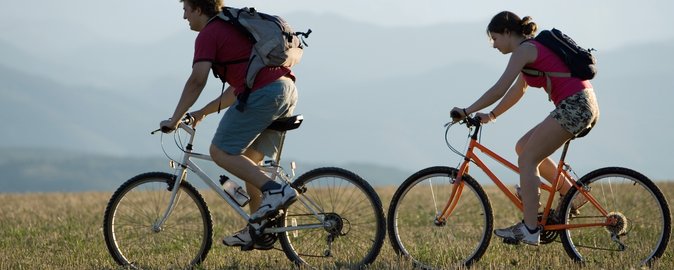- Education
-
Research
Current research
Talent
-
Collaboration
Businesses
Government agencies and institutions
Alumni
-
About AU
Organisation
Job at AU
Even though the Danes are among the world leaders when it comes to using their bikes on an everyday basis, Denmark is less popular than it used to be as a destination for cycle tourists. An anthropologist from AU has been studying the phenomenon of cycle tourism to find out what it takes to enjoy a holiday on wheels.
2013.06.24 |

Mads Daugbjerg and his team of fieldworkers interviewed tourists at five selected locations. They collected a substantial body of material consisting of videos, photos, and postcards and diaries written by the tourists.
Let’s just start by defining what we mean by the term ‘cycle tourist’:
“It’s a tourist whose main holiday goal involves either cycling on day trips from a single base, or cycling from one location to the next,” explains associate professor Mads Daugbjerg, whose research focuses on cultural tourism and in particular the interface between cultural heritage, experience tourism and identity.
He has just completed a research project in collaboration with VisitDenmark and other stakeholders in the tourism industry. The aim was to find out what constitutes a good cycling holiday.
“We Danes are famous abroad for our strong, broad cycling culture. For instance, Copenhagen has been elected more than once as the best city in the world for cycling. But even though Danish cycling culture is part of the Danish tourist brand, other European countries are now more popular than Denmark as destinations for a cycling holiday. So the aim of our project was to generate new ideas to encourage more people to take a cycling holiday in Denmark,” says Daugbjerg.
A rolling stone gathers no moss
But before you can develop new ideas, you need to know something about the people you are studying. They all love their bikes of course, but how do cycle tourists describe themselves in contrast to other holidaymakers? That was one of the questions that Mads Daugbjerg and his team studied during their fieldwork on the roads of Denmark, Austria and Germany.
“Cycle tourists define themselves as the opposite of car drivers. And they see themselves as rolling stones, unlike people who put down roots and stay at one campsite all summer. That might not be a particularly surprising conclusion; but it was only one of the results of our ethnographic fieldwork, the purpose of which was to study cycling tourism at grassroots level by studying the people who actually do it. This approach helped us to learn about the motivation and preferences of cycle tourists based on actual experience,” explains Daugbjerg.
He and his team of fieldworkers interviewed tourists at five selected locations. They collected a substantial body of material consisting of videos, photos, and postcards and diaries written by the tourists. The method helped the project to comply with the demand of the tourist industry for qualitative insight and knowledge about cycle tourists.
Better cycling in Denmark
“Some cycle tourists enjoyed the spiritual aspect of cycling, while others attached greatest importance to their physical performance. Many of them said they enjoyed visiting exclusive locations, and that in general they viewed cycle tourism as a way to live the good life. And finally, a lot of them regarded a sense of freedom as one of the core qualities of cycling,” says Daugbjerg.
According to Daugbjerg, there were two surprising results in particular: (1) cycle tourists felt that moving from one place to the next was an essential ingredient of their holiday experience. Good cycling was not bound to specific locations. And (2) cycle tourists enjoyed visiting ‘exclusive’ locations, This was the kind of grassroots insight that Mads Daugbjerg and his team were able to pass on to the Danish tourist industry:
“One of the main challenges facing the tourist industry is how to improve the way we market cycling holidays in Denmark, given that what most cyclists want is movement rather than static links to specific locations,” explains Daugbjerg.
The ethnographic fieldwork resulted in a number of concrete questions for the tourist industry, and has been used by stakeholders in the industry as a springboard for the development of new holiday concepts to crank Danish cycling tourism up a gear or two. One of these new concepts is called ‘Hidden cycling treasures in the Viborg Region’. And the project also generated a number of other innovative ideas.
Facts about “Good cycling experiences”
Facts about Danish cycling tourism
Did you know that:
Source: Visit Denmark / Danish Cycling Federation
For further information
Associate professor Mads Daugbjerg
Aarhus University, Department of Culture and Society, Anthropology and Ethnography
Mail: mads.daugbjerg@hum.au.dk
Tel.: 8716 2128